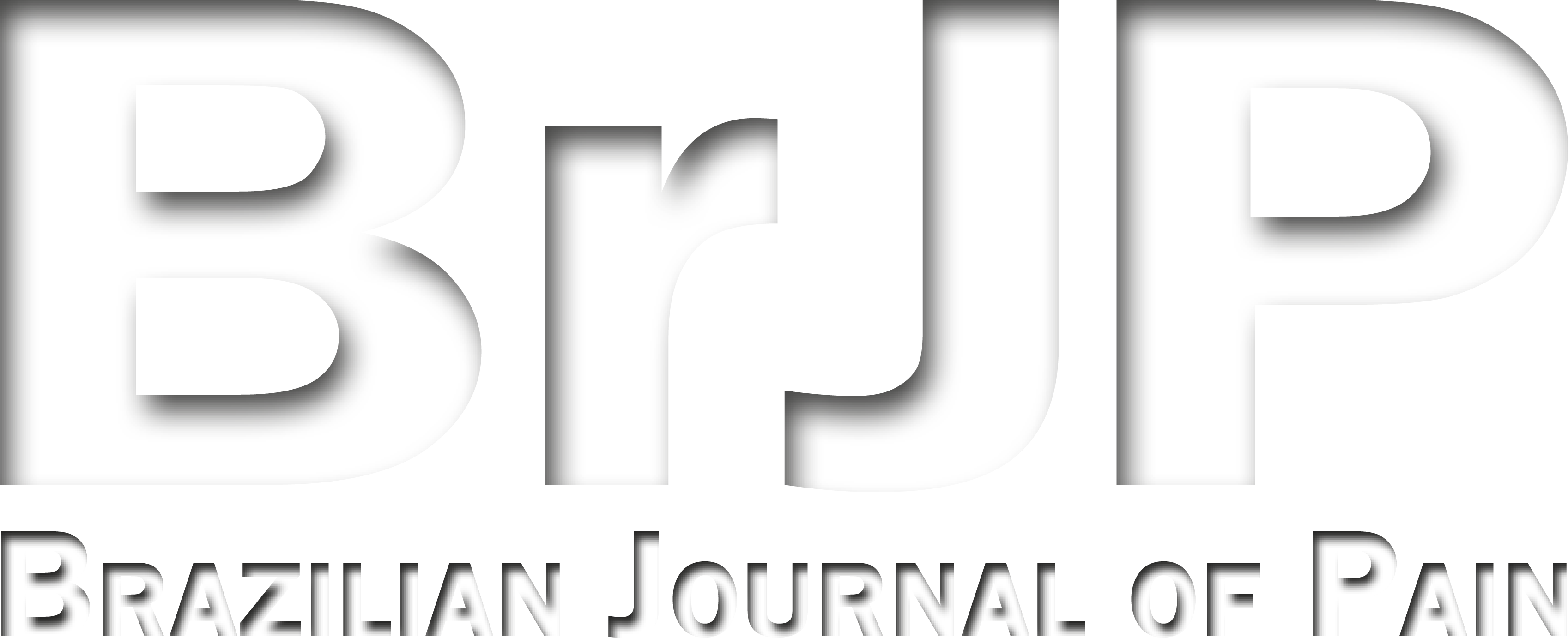Postoperative pain behavior differs according to type of stimulus in rats
Comportamento em dor pós-operatória varia conforme o tipo de estímulo em ratos
Omar Ashmawi; Eduardo Pio Cunha; Danilo Ramirez De-Gregori; Hazem Adel Ashmawi
Abstract
BACKGROUND AND OBJECTIVES: This study addressed the role of skin and deep tissue incisions in two different models of postoperative pain in rats, plantar incision and gastrocnemius incision models.
METHODS: After approval from the Ethics Committee of the institution, male Wistar rats were used in two different experiments. One group of animals was used in the plantar incision model and divided in three groups: sham incision, skin incision and skin and muscle and fascia incision (deep tissue incision). Another group was used in the gastrocnemius incision model and divided into three other groups: sham incision, skin incision and muscle and fascia incision. The animals in the plantar incision model were assessed for paw withdrawal threshold, and the time spent by the animals in the gastrocnemius incision model in the running wheel was recorded.
RESULTS: Skin and skin + deep tissue plantar incisions increased hyperalgesia after mechanical stimulus in the paw. Hyperalgesia lasted in the skin group until the 3rd postoperative day (POD), in the skin + deep tissue incision group, hyperalgesia lasted until the 4th POD. Skin and skin + deep tissue groups were significantly different on the 1st, 2nd, 3rd and 4th POD. Time spent in the running wheel was lower in the skin + deep tissue group on the 1st and 2nd POD.
CONCLUSION: Pain behavior elicited after mechanical stimulus in skin and deep tissue incision is more intense than skin incision in the plantar incision model, however, skin and skin + deep tissue incision elicited the same behavior in gastrocnemius incision model.
Keywords
Resumo
JUSTIFICATIVA E OBJETIVOS: Este estudo abordou o papel das incisões na pele e nos tecidos profundos em dois modelos diferentes de dor pós-operatória em ratos, modelos de incisão plantar e incisão do gastrocnêmio.
MÉTODOS: Após a aprovação do Comitê de Ética da instituição, ratos Wistar machos foram usados em dois experimentos diferentes. Um grupo de animais foi usado no modelo de incisão plantar e dividido em três grupos: incisão sham, incisão na pele e incisão na pele e músculo e fáscia (incisão em tecido profundo). Outro conjunto foi usado no modelo de incisão de gastrocnêmio e dividido em três grupos: incisão sham, incisão na pele e incisão no músculo e fáscia. Os animais no modelo de incisão plantar foram avaliados quanto ao limiar de retirada da pata, e nos animais do grupo de incisão do gastrocnêmio, o tempo gasto pelos animais na roda giratória foi registrado.
RESULTADOS: As incisões plantares na pele e na pele + tecido profundo aumentaram a hiperalgesia após estímulo mecânico na pata. A hiperalgesia durou no grupo pele até o 3º dia pós-operatório (DPO), no grupo pele + incisão em tecido profundo, a hiperalgesia durou até o 4º DPO. Os grupos pele e pele + tecido profundo foram significativamente diferentes entre si no 1º, 2º, 3º e 4º DPO. O tempo gasto na roda de corrida foi menor no grupo pele + tecido profundo no 1º e 2º DPO.
CONCLUSÃO: O comportamento de dor provocado após estímulo mecânico na pele e incisão em tecido profundo é mais intenso do que na incisão da pele no modelo de incisão plantar, no entanto, incisões na pele e na pele + incisão em tecido profundo provocaram o mesmo comportamento no modelo de incisão no gastrocnêmio.
Palavras-chave
References
1 Gulur P, Nelli A. Persistent postoperative pain: mechanisms and modulators. Curr Opin Anaesthesiol. 2019;32(5):668-73.
2 Weiser TG, Haynes AB, Molina G, Lipsitz SR, Esquivel MM, Uribe-Leitz T, Fu R, Azad T, Chao TE, Berry WR, Gawande AA. Size and distribution of the global volume of surgery in 2012. Bull World Health Organ. 2016;94(3):201-209F.
3 American Society of Anesthesiologists Task Force on Acute Pain Management. Practice guidelines for acute pain management in the perioperative setting: an updated report by the American Society of Anesthesiologists Task Force on Acute Pain Management. Anesthesiology. 2012;116(2):248-73.
4 Xu J, Brennan TJ. Comparison of skin incision vs. skin plus deep tissue incision on ongoing pain and spontaneous activity in dorsal horn neurons. Pain. 2009;144(3):329-39.
5 Xu J, Brennan TJ. Guarding pain and spontaneous activity of nociceptors after skin versus skin plus deep tissue incision. Anesthesiology. 2010;112(1):153-64.
6 Kang S, Lee D, Theusch BE, Arpey CJ, Brennan TJ. Wound hypoxia in deep tissue after incision in rats. Wound Repair Regen. 2013;21(5):730-9.
7 Pogatzki-Zahn E, Segelcke D, Zahn P. Mechanisms of acute and chronic pain after surgery: update from findings in experimental animal model. Curr Opin Anaesthesiol. 2018;31(5):575-85.
8 Zimmermann M. Ethical guidelines for investigations of experimental pain in conscious animals. Pain. 1983;16(2):109-10.
9 Brennan TJ, Vandermeulen EP, Gebhart GF. Characterization of a rat model of incisional pain. Pain. 1996;64(3):493-502.
10 Ogonda L, Wilson R, Archbold P, Lawlor M, Humphreys P, O'Brien S, Beverland D. A minimal-incision technique in total hip arthroplasty does not improve early postoperative outcomes. A prospective, randomized, controlled trial. J Bone Joint Surg Am. 2005;87(4):701-10.
11 Dorr LD, Maheshwari AV, Long WT, Wan Z, Sirianni LE. Early pain relief and function after posterior minimally invasive and conventional total hip arthroplasty. A prospective, randomized, blinded study. J Bone Joint Surg Am. 2007;89(6):1153-60.
12 Pogatzki EM, Niemeier JS, Brennan TJ. Persistent secondary hyperalgesia after gastrocnemius incision in the rat. Eur J Pain. 2002;6(4):295-305.
Submitted date:
09/09/2024
Accepted date:
11/14/2024


